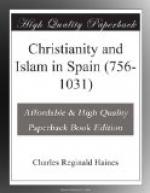[1] For an attempted compromise
between Christianity and
Brahmanism, see the proceedings
of Beschi, a Roman Catholic
priest, “Education and
Missions,” p. 14.
[2] Cp., however, the Druse religion.
[3] Dozy, ii. 184. Dozy adds that Abdurrahman was called the Galician (el Jaliki) in consequence of this attempt of his: but there is some error here, as Ibn Hayyan (see Al Makkari, ii. 439, and De Gayangos’ note) says he was called ibn ul’jaliki, i.e., of the stock of the Galicians.
But though no religion, holding a position midway between Islam and Christianity, arose in Spain, yet those religions could hardly fail to undergo considerable modifications in themselves by reason of their close contact for several centuries.
In respect to Christianity we shall naturally find the traces (if any) of such modification in the so-called heresies which may have arisen in Spain during this period. These will require a somewhat strict examination to be made to yield up their secret.
The Church of Spain seems to have gained a reputation for introducing innovations[1] into the doctrines and practices of the true faith, and even of priding itself on its ingenuity in this way. The very first Council whose acts have come down to us, held at Elvira in Spain, early in the fourth century, contains a canon censuring the use of pictures. The very first heretics, who were punished for their error with death by the hands of their fellow-Christians, were reared in the bosom of the Spanish Church. The doctrine, novel then, but accepted now by all the Western Churches, of the Procession of the Holy Ghost from the Son as well as from the Father, was first formulated in a Spanish Council at the end of the sixth century, but not universally received in the West until 600 years later.[2] And as we have seen, the use of pictures was denounced long before the times of the Iconoclasts.




